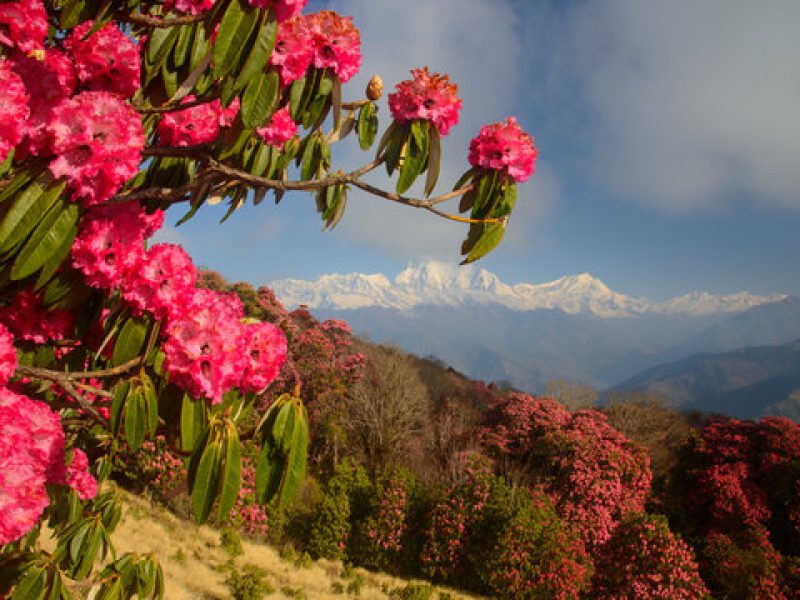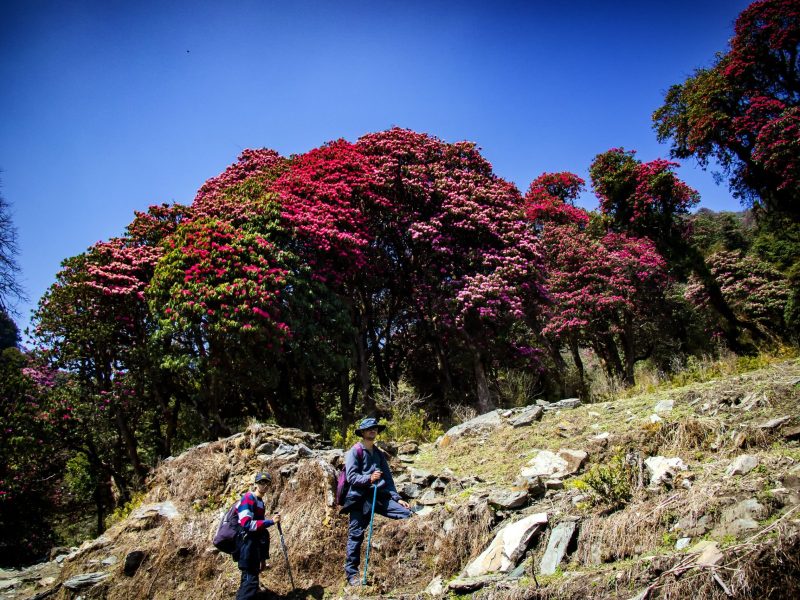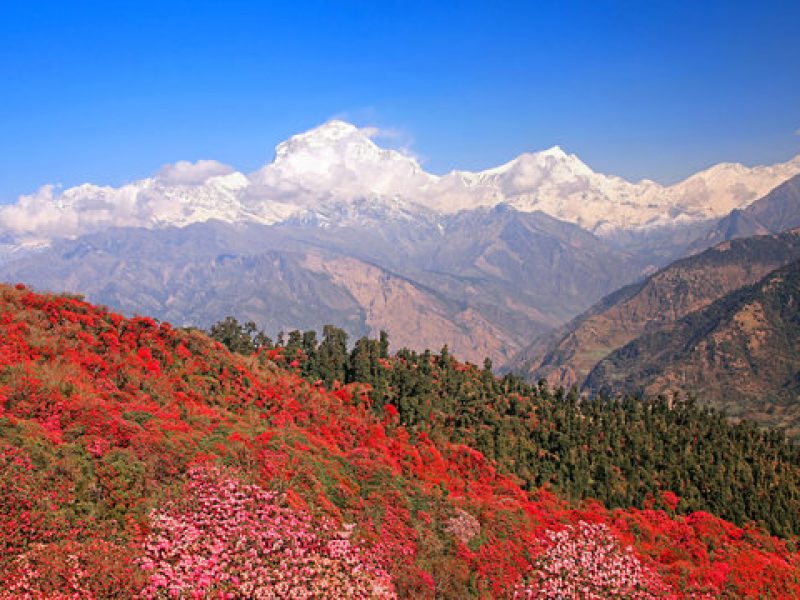The Rhododendron “Laligurans” is a botanical wonder with vibrant crimson blossoms originating from the Himalayas. It blooms in temperate climates and stands tall with delicate petals.
The glossy, dark green leaves create a captivating contrast. The plant holds cultural significance in Nepalese folklore symbolizing love and nature. Its annual blooming signifies spring and is celebrated in festivals and ceremonies.
The Rhododendron “Laligurans” is a stunning flora species known for its crimson blooms and delicate petals. It blooms in temperate climates and is deeply rooted in Nepalese folklore.
The flower symbolizes love, passion and the long lasting spirit of nature. Its tall, proud branches and glossy, dark green leaves create a breathtaking spectacle.
Description Of The Rhododendron “Laligurans’’
The Rhododendron “Laligurans” is a stunning evergreen shrub with crimson flowers and glossy, dark green leaves. It grows to 1 to 3 meters and has sturdy branches. The leaves are elliptical or leathery and shiny measuring 5 to 10 centimeters in length.
The most remarkable feature is its vibrant, trumpet-like flowers which bloom in clusters at the ends of branches. It blooms in acidic soils and partial shade but excessive exposure can blacken its leaves.
Cultural Significance Of The Rhododendron “Laligurans’’
The Rhododendron “Laligurans” is a significant cultural symbol in Nepalese folklore, representing life, love and the natural world. Its vibrant crimson blooms symbolize deep affection and desire making it a popular choice for romantic gestures.

In Hindu mythology, the flower is associated with the goddess Saraswati, inspiring creativity. The Rhododendron Festival in the Himalayas celebrates its blooming, featuring cultural performances and traditional music. The plant’s leaves and flowers are used in traditional medicine and fragrant oils and perfumes.
Ecological Importance Of The Rhododendron “Laligurans’’
The Rhododendron “Laligurans” is a crucial species in the Himalayan ecosystems, contributing to soil stability, erosion control and habitat for wildlife. Its dense roots anchor soil, preventing erosion on steep mountain slopes.
The shrub’s dense leaves and abundant flowers attract pollinators facilitating the reproduction of other plant species. The fallen leaves contribute to nutrient cycling in the soil, enriching it and promoting ecosystem health.
It also regulates water flow in mountainous regions, absorbing water during heavy rainfall and releasing it during drought. Protecting and conserving this species is vital for the resilience of Himalayan ecosystems.
Uses Of The Rhododendron “Laligurans’’
For centuries, people have utilized the Rhododendron “Laligurans” in traditional medicine, religious ceremonies, aromatherapy, ornamental landscaping, honey production, and woodworking. They have extracted medicinal properties from its leaves, flowers, and bark, employing them in infusions and herbal remedies for various ailments.
The vibrant crimson blooms are used in religious ceremonies, and fragrant oils are used in perfumes, incense, and aromatherapy products. The plant’s glossy leaves add color and beauty to gardens and its nectar-rich flowers attract bees making it an essential source of honey.
The durable wood is used in woodworking and carpentry making it suitable for crafting furniture and decorative items.
Varieties And Hybrids Of The Rhododendron “Laligurans”
The Rhododendron “Laligurans” is a diverse plant family with various varieties and hybrids. The iconic species, Rhododendron arboreum, known for its crimson flowers and dark green leaves, originates from the Himalayan region and exhibits robust growth.
In southwestern China, the subspecies Rhododendron arboreum produces smaller, bell-shaped flowers, and it also produces white flowers, while breeders have developed hybrids through crossbreeding with other species. Cultivars within each variety and hybrid offer a wide range of options for gardeners and collectors.
Caring Of The Rhododendron “Laligurans”
To ensure the health and vitality of the Rhododendron “Laligurans,” it is essential to choose a planting location with partial shade, well-draining soil and acidic soil with a pH between 4.5 and 6.0.

Plant the plant in early spring or fall, water it consistently but not overly and apply organic compost around the base to conserve moisture and regulate soil temperature. Feed the plant with a balanced, slow-release fertilizer, prune after flowering to remove dead or diseased branches and protect them from frost by covering them with frost cloth.
By following these guidelines, you can ensure the plant thrives and brings beauty to your garden for years to come.
Challenges & Threats Of The Rhododendron “Laligurans”
The Rhododendron “Laligurans” faces numerous threats in its native and cultivated environments. Habitat loss due to deforestation, urbanization and agricultural expansion reduces the plant’s growing space and disrupts ecosystems.
Climate change alters temperature and precipitation patterns, affecting the plant’s growth and health. Invasive species compete for resources, weakening the plant. Diseases and pests such as fungal infections and bacterial diseases weaken the plant.
Over-collection from the wild, especially in rare or endemic areas, threatens the species’ genetic diversity. Air pollution, particularly sulfur dioxide and nitrogen oxides, can damage the plant’s leaves and weaken its health. Climate extremes can also negatively impact the plant’s growth and flowering.
National Symbolism Of The Rhododendron “Laligurans”
The Rhododendron “Laligurans” is a national flower in Nepal, symbolizing love, passion, and nature’s beauty. It is deeply ingrained in Nepalese culture, traditions, and identity, reflecting the resilience of the people.
The vibrant crimson blooms symbolize vitality and strength, reflecting the resilience of the Nepalese people. The flower is also a symbol of national pride, conservation efforts, tourism, and environmental protection.
Its inclusion in national emblems, flags and official documents reinforces its status as a cherished national symbol. The Rhododendron’s vibrant blooms inspire pride, unity and stewardship among the Nepalese people.
Cultural Celebrations Of The Rhododendron “Laligurans”
The Rhododendron “Laligurans” is a significant flower in the Himalayas, celebrated through various events. These include annual festivals, religious ceremonies, cultural parades, photography and art competitions, educational workshops and culinary events.
These celebrations highlight the region’s cultural heritage, traditions and natural beauty, bringing communities together in joyous festivities. Visitors gather to witness the stunning display of the flower and participate in the festivities.
In Nepal, offerings of “Laligurans” flowers are made in temples and shrines as symbols of devotion and reverence. The festival also includes educational workshops on botany, ecology, and environmental conservation, raising awareness about the Rhododendron’s ecological significance. Ultimately, these celebrations honor the Rhododendron and inspire stewardship of the environment for future generations.
Tourism And Promotion Of The Rhododendron “Laligurans”
Tourism promotion strategies for the Rhododendron “Laligurans” are crucial in attracting visitors to regions where the iconic flower blooms. These strategies include organizing annual Rhododendron festivals offering guided nature tours and trekking expeditions, offering photography and art workshops and offering cultural experiences that highlight the Rhododendrons significance in local traditions and folklore.
These activities cater to different interests and fitness levels, promoting the Rhododendron as a focal point of the experience. Additionally, promoting the Rhododendron as a flagship species for environmental conservation and sustainability initiatives raises awareness about the importance of preserving the Rhododendrons natural habitat.
By offering a diverse range of experiences, these strategies can showcase the Rhododendron as a unique and compelling tourism attraction.
Research & Development Of The Rhododendron “Laligurans”
The Rhododendron “Laligurans” is under the spotlight of various research and development initiatives. These include botanical studies, ecological research, conservation genetics, horticultural research, medicinal and pharmacological studies, environmental conservation and cultural and socio-economic studies.
Botanical studies involve taxonomic and morphological analysis to understand the species’ taxonomy, anatomy, and evolutionary history. Ecological research investigates the plant’s role in its native habitats, interactions with other plant species, wildlife and environmental factors.
Conservation genetics assesses genetic diversity and population structure, while horticultural research focuses on breeding and cultivar development to improve the plant’s ornamental value.
Lastly, environmental conservation aims to mitigate threats to the plant and its habitats. Finally, cultural and socio-economic studies explore the cultural significance of the plant in local communities.
Global Significance Of The Rhododendron “Laligurans”
The Rhododendron “Laligurans” is a globally recognized symbol of biodiversity, cultural heritage and environmental resilience. It is a native species of the Himalayan region, a biodiversity hotspot and a key indicator species for monitoring climate change impacts on mountain ecosystems.
The flower’s cultural significance extends beyond its native range, featuring prominently in art, literature and folklore. Its vibrant blooms attract tourists to destinations where it is cultivated or occurs naturally.
The plant also holds medicinal and horticultural value, with bioactive compounds used in traditional medicine and ornamental value in gardens and landscapes.
It is a conservation priority at both national and international levels, contributing to broader conservation goals aimed at preserving biodiversity, mitigating climate change and promoting sustainable development.
Conservation Effort Done To Protect Rhododendron Forest
Rhododendron forests are crucial ecosystems that require various conservation strategies to preserve their biodiversity, ecological integrity and cultural heritage.
These strategies include habitat protection, community-based conservation, habitat restoration, aggressive species management, research and monitoring, legislation and policy and public awareness and education.

Protected areas like national parks, wildlife sanctuaries and nature reserves provide legal designations and management measures to regulate human activities and prevent habitat destruction.
Community-based conservation involves empowering local communities to participate in decision-making, resource management and conservation activities. Public awareness campaigns and outreach activities promote responsible stewardship of Rhododendron forests.
Habitat restoration involves reforestation, afforestation and habitat restoration projects to rehabilitate ecosystems impacted by deforestation and logging. Aggressive species management involves overpowering species surveys, eradication efforts and prevention measures.
Conclusion
In conclusion, The Rhododendron “Laligurans” is a symbol of Nepal’s national pride, cultural heritage, and environmental resilience. Its vibrant blooms and glossy foliage inspire and highlight the diversity of the Himalayan landscape. Beyond Nepal, it holds global significance for biodiversity, climate resilience, and cultural heritage. However, it faces threats like habitat loss, climate change, invasive species, and over-collection. To protect and preserve the species, we need sustainable land management practices, conservation initiatives, public awareness, and community engagement.
Frequently Asked Questions (FAQs)
1. What does the name “Laligurans” mean?
“Laligurans” is a Nepali word that translates to “red rhododendron” in English. The vibrant crimson blooms of the Rhododendron arboreum species, designated as the national flower of Nepal, refer to its defining feature.
2. Where can I find Rhododendron “Laligurans”?
Rhododendron “Laligurans” is native to the Himalayan region, including countries such as Nepal, Bhutan, India, and Tibet. It typically grows in mountainous forests and alpine meadows at elevations ranging from 2,000 to 4,000 meters above sea level.
3. What is the significance of Rhododendron “Laligurans” in Nepalese culture?
In Nepal, the national flower “Laligurans” holds deep cultural significance, revered for its association with love, passion, and beauty. Its vibrant blooms feature prominently in religious ceremonies, cultural festivals, and traditional medicine practices.
4. When does Rhododendron “Laligurans” bloom?
The blooming season of Rhododendron “Laligurans” varies depending on factors such as elevation and climate. In Nepal, the peak blooming season typically occurs from March to May, coinciding with the arrival of spring in the Himalayan region.
5. Is Rhododendron “Laligurans” only found in Nepal?
Rhododendron “Laligurans,” designated as the national flower of Nepal, also grows in other countries within the Himalayan range, including Bhutan, India, and Tibet. The species may have different local names in these regions.
6. Can I grow Rhododendron “Laligurans” in my garden?
Rhododendron “Laligurans” can be grown in gardens and landscapes in regions with suitable climate and soil conditions. It prefers acidic soil, partial shade, and cool, moist climates. There are many cultivars and hybrids available for cultivation in a variety of garden settings.
Introducing Trek Me Nepal: Embark on Unforgettable Journeys
At Trek Me Nepal, every step you take should be an adventure, every breath you inhale should be filled with the essence of nature, and every heartbeat should resonate with the rhythm of the mountains. We are a passionate team of explorers committed to crafting unforgettable trekking experiences in the breathtaking landscapes of Nepal.

Comment (0)